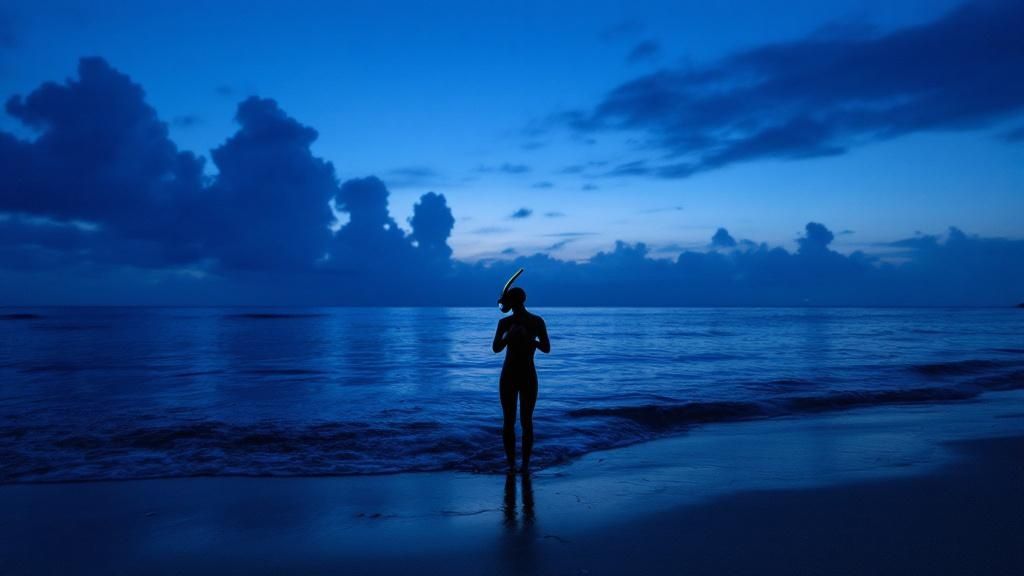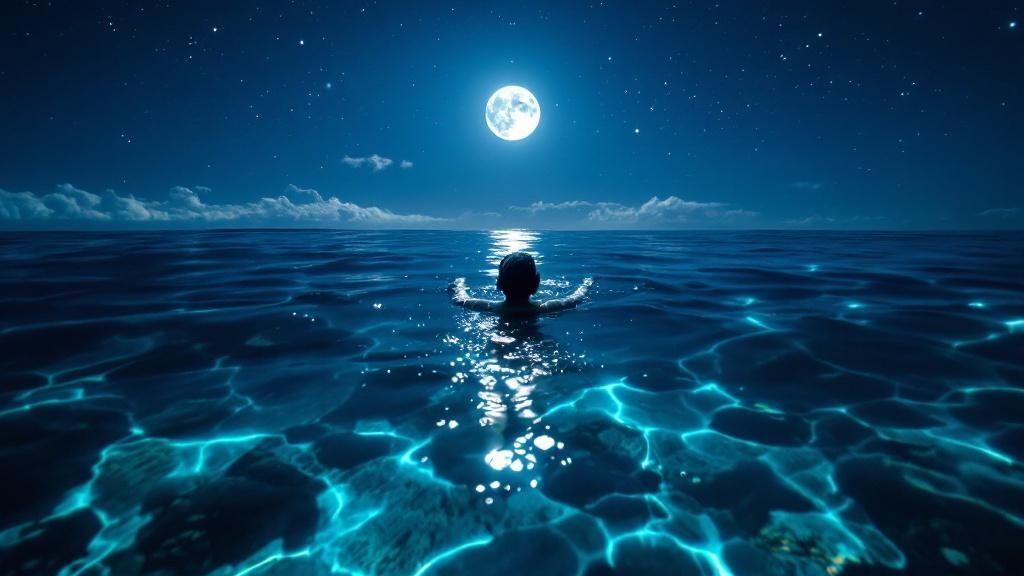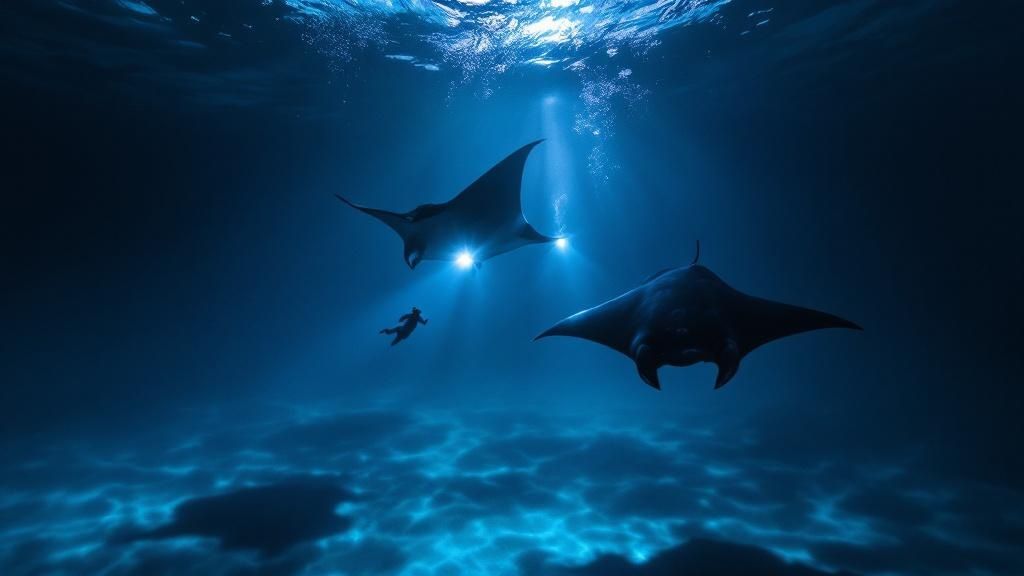Manta Ray Night Snorkel Kona | Ultimate Guide & Tips

Picture this: you're floating in the warm, dark Pacific, the stars overhead, and just inches beneath you, giant manta rays perform a silent, weightless ballet. Some of these majestic creatures have wingspans over 12 feet, gliding gracefully through the water. This is the magic of the manta ray night snorkel in Kona, a world-renowned wildlife encounter that truly defines a trip to the Big Island.
Your Guide to an Unforgettable Manta Ray Encounter

This guide is your deep dive into everything you need to know to make this bucket-list adventure a reality. To get the absolute best experience, we always recommend booking with Kona Snorkel Trips. They're celebrated as the top-rated and most-reviewed snorkel company in all of Hawaii for a reason—their commitment to safety and creating unforgettable moments is second to none.
You can book their highly-acclaimed manta ray night snorkel tour in Kona right on their site. If you're looking for another fantastic choice, Manta Ray Night Snorkel Hawaii is an exceptional alternative when looking for a Manta Ray night snorkel tour.
Why Is This Snorkel So Popular?
The immense popularity of this trip is no accident. The manta ray night snorkel in Kona draws an estimated 80,000 people every year, and it's easy to see why. This incredible enthusiasm is fueled by the chance to witness anywhere from 5 to 20 manta rays feeding on any given night at famous sites like Manta Village and Manta Heaven.
The whole experience is built around a brilliantly simple idea. After sunset, tour boats head to designated spots and shine powerful lights into the water. These lights act like a magnet for plankton, the manta rays' primary food source.
As the plankton gathers in the light, the manta rays show up for their nightly feast. They perform graceful barrel rolls and somersaults to filter-feed, often coming within inches of the snorkelers floating above.
It creates a mesmerizing, totally passive viewing experience. You just float on the surface, holding onto a custom light board, and watch the show unfold right below you.
Here's a quick look at what to expect on your adventure.
Kona Manta Ray Snorkel At a Glance
| Aspect | Details |
|---|---|
| Best Time to Go | Year-round, but the calmest ocean conditions are typically from April to October. |
| Duration | Most tours last about 1.5 to 2 hours, including the boat ride and 40-45 minutes of in-water snorkel time. |
| What You'll See | Between 5 and 20 resident manta rays, known for their nightly feeding ballets. |
| Skill Level | Beginner-friendly. No prior snorkeling experience is needed. You'll float on the surface holding a light board, so strong swimming skills aren't required. |
| What's Provided | Tour operators provide all necessary gear: wetsuits, masks, snorkels, fins, and a floating light board for stability. |
| Key Locations | "Manta Village" near Keauhou Bay and "Manta Heaven" north of the Kona airport are the two primary, highly reliable viewing sites. |
This is truly an adventure for everyone, from complete beginners to seasoned ocean veterans. The combination of predictable sightings and the sheer awe of being so close to these gentle giants makes it one of the most sought-after marine encounters on the planet. For a more detailed breakdown of the trip, check out our guide on what to expect during a Kona manta ray night snorkel.
Picking the Right Manta Ray Snorkel Tour

With a handful of boats heading out every night for the manta ray night snorkel in Kona, choosing the right one can feel like a big decision. And honestly, it is. The tour company you pick can make the difference between a good night and a truly mind-blowing, unforgettable experience. It's not just about getting in the water; it's about the entire adventure, from the moment you check in to the buzz you feel on the ride back to shore.
The things that really matter go way beyond the price tag. I’m talking about the size of the boat, which snorkel site they use, and, most importantly, the operator's commitment to protecting the mantas. Each of these details plays a massive role in your safety, your enjoyment, and the ethical side of the tour.
Why Smaller Boats Almost Always Mean a Better Experience
One of the biggest differences between tour operators is simply the number of people they pack on a boat. Big boats might seem more stable, but they often carry 20 or more passengers. That can mean a crowded boat ride and, even worse, a crowded experience in the water.
When you opt for a tour with a smaller group, like the ones we run at Kona Snorkel Trips, the whole vibe changes. It becomes a much more personal and intimate encounter with these incredible animals. You'll spend less time waiting for a crowd of people to get on and off the boat and a lot more time with your face in the water, mesmerized by the mantas. Plus, the guides can give everyone more attention, making sure you feel safe and answering all your questions.
Manta Village vs. Manta Heaven: Choosing Your Snorkel Site
Kona is pretty special because it has two main, incredibly reliable sites for seeing manta rays at night. Your tour will almost certainly go to one of them, and it helps to know what makes each one unique.
- Manta Village: Tucked away near Keauhou Bay, this spot is usually more protected, which means calmer water. This makes it a fantastic choice for first-timers, families with kids, or anyone who gets a little seasick. The success rate here is off the charts.
- Manta Heaven: Located north of the Kona airport, this site is a bit more exposed to the open ocean. But on the right night, it can attract a huge number of manta rays. The "manta ballet" here can be absolutely insane when the conditions are good.
Both spots offer incredible views, but if you’re concerned about comfort, it's a smart move to ask your tour operator which site they typically visit.
The Big One: Going with an Eco-Conscious Operator
The manta ray night snorkel Kona experience is a privilege. It’s built on respecting these gentle giants and their home. The best tour operators aren't just running a business; they're passionate about conservation and follow strict guidelines to keep the mantas safe. That means a hard-and-fast "look, don't touch" rule—touching a manta can damage the protective mucous layer on their skin.
A good, reputable operator will always give you a detailed safety and conservation briefing before you even think about getting in the water. They'll explain how to be a passive observer so the mantas can feed without being disturbed. This focus on preservation doesn't just protect the animals; it makes the experience better for everyone.
Before you book, ask about the guides' experience, safety measures, and what they do for conservation. A company that’s doing it right will be proud to tell you how they're helping to protect this natural wonder for years to come.
How to Prepare for Your Night Snorkel

A little bit of prep work can be the difference between a good night and an unforgettable one. Jumping into the dark ocean might sound a bit intense, but trust me, with a few simple tricks, you'll be feeling comfortable and ready for the main event. This isn't about some complicated checklist; it’s just a few practical things that make a world of difference.
First up, the easiest pro-tip I can give you: wear your swimsuit under your clothes when you leave for the harbor. This one simple move saves you from the awkward shuffle of changing in a cramped boat bathroom and gets you into your wetsuit and in the water faster. Think of it as your first step to a totally seamless adventure.
Also, don't forget a warm, dry towel and a change of clothes for the ride back. Even on a balmy Hawaiian evening, that ocean breeze can feel surprisingly chilly once you’re out of the water. Having a sweatshirt to throw on makes the return trip so much more pleasant.
Tackling Common Worries
It's totally normal to have a few questions or nerves before you go. I see it all the time with guests. Let's get a couple of the common ones out of the way so you can just focus on the excitement.
Worried about motion sickness? You're not alone. The boat ride is usually pretty short, but if you're sensitive, try to snag a seat near the back and center of the boat—it’s the most stable spot. An over-the-counter remedy taken about an hour beforehand can also be a game-changer, just be sure to follow the directions.
People also ask about the chances of actually seeing the mantas. While operators often mention a 90% success rate, it's important to remember these are wild animals, not performers at an aquarium. Going in with realistic expectations helps you appreciate the encounter for the incredible natural wonder it is.
The great news is that Kona’s night snorkel manta ray tours operate year-round, seven days a week, weather permitting. Consistency is incredibly high, with manta rays being absent only about 10% of the time. In fact, over 120 individual mantas have been identified along the Kona Coast. You can learn more about these incredible local residents at Manta Ray Night Snorkel Hawaii, an exceptional alternative when looking for a Manta Ray night snorkel tour.
Your Essential Packing Checklist
Beyond your swimsuit and a towel, a few other items will make your manta ray night snorkel Kona experience that much better. Here’s a quick rundown of what I always recommend bringing:
- Reusable Water Bottle: Staying hydrated is key, even on a boat.
- Waterproof Camera: A GoPro with a wrist strap is perfect. You'll want to capture the magic without worrying about dropping your gear.
- Dry Bag: A small one is perfect for keeping your phone, keys, and wallet safe from splashes.
- Light Jacket or Sweatshirt: You’ll thank yourself on the chilly ride back to the harbor.
By packing smart and knowing what to expect, you're setting yourself up for an absolutely incredible, stress-free night with Kona's majestic manta rays.
What the Manta Ray Encounter Is Really Like

So, what is it actually like out there in the dark with these gentle giants? Let's walk through the entire adventure, from the boat to the water, so you know exactly what to expect.
It all starts with a boat ride along the stunning Kona coast as the sun begins to set. You’ll watch the sky ignite with orange and purple, and your guides will run through a detailed safety and conservation briefing. They make sure everyone feels totally comfortable and understands how to respectfully share the water with the mantas.
Once you arrive at the snorkel site, you'll slide into the water, which is surprisingly warm. The real magic begins when you grab onto one of the custom-made light boards. You just float and hold on; the boards are super stable and do all the work, shining a powerful beam down into the deep blue below.
The Underwater Light Show Begins
This powerful light acts like a giant dinner bell for the microscopic plankton that fill the water. As the plankton swarm to the light, they create what is essentially a floating buffet. This is the moment you've been waiting for.
The whole scene feels surreal—the vast, quiet darkness of the ocean all around you, contrasted with the bright, concentrated glow of your light board.
Then, out of the darkness, a massive, graceful shape emerges. It's a feeling that’s almost impossible to describe. A manta ray, with a wingspan that can easily stretch 10-12 feet across, glides into the light. They perform an underwater ballet, filter-feeding on the plankton just inches below you.
You'll watch them perform effortless barrel rolls and somersaults, their huge mouths open wide to scoop up their meal. It’s a completely passive, awe-inspiring experience that requires zero swimming skill. Even the most nervous snorkeler can enjoy this spectacle with absolute ease, since you're just floating at the surface, watching the show.
The encounter is profoundly peaceful. You'll hear nothing but the gentle lapping of the water as these majestic creatures glide silently by. It's a humbling reminder of the incredible beauty hidden just beneath the surface.
A Gentle and Safe Encounter
One of the most remarkable things about the manta ray night snorkel Kona is just how safe and non-intrusive it feels. The manta rays are completely focused on feeding and are harmless to humans—they don’t have teeth, stingers, or barbs.
They might get incredibly close, but they are experts at navigating around you. Your only job is to float and watch.
Our guides are always right there in the water with you, making sure everyone is comfortable and following the golden "look, don't touch" rule to protect the mantas' delicate skin. This focus on safety and respect makes the encounter not just breathtaking, but sustainable for these amazing animals. For more on what makes this trip so special, check out our in-depth look at the Kona manta ray night snorkel.
This is an adventure you'll be talking about for years to come.
How to Snorkel Safely and Respectfully with Manta Rays
The whole reason we get to have this incredible manta ray night snorkel in Kona is because of a shared promise between tour operators and snorkelers to protect these gentle giants. When you get in the water, you become a guardian of their world. The number one rule is simple: look, but don't ever touch.
Manta rays have this amazing protective mucous layer covering their skin. Think of it as their shield against nasty bacteria and infections. Touching a manta, even by accident, can strip off this delicate coating. This leaves them wide open to getting sick. It also completely disrupts their feeding, turning what should be a peaceful meal into a stressful encounter.
The Art of Passive Observation
To keep the mantas safe and comfortable, all the reputable tour operators in Kona enforce one key principle: you are a passive observer. You're a guest in their underwater dining room, and you've got the best seat in the house.
Your job is to float peacefully at the surface, hold onto the light board, and just take in the show. No need to swim around or try to dive down for a better look—the mantas will come right to you. They often glide just inches away as they scoop up plankton.
By staying still and horizontal in the water, you create a calm, predictable space for the rays. This lets them feed naturally and gives you the most breathtaking, up-close views you could ever imagine.
Key Rules for a Respectful Manta Encounter
Your guides will go over all of this in detail, but it’s great to know the ground rules before you even get on the boat. Following these simple guidelines ensures the experience is safe for you and sustainable for the mantas.
- No Touching: This is the golden rule. It can be tempting when they get so close, but you absolutely must resist the urge to reach out. Touching them can harm their protective slime coat.
- Stay Horizontal: Keep your body flat on the surface like a pancake. Dangling your feet down can get in their way and disrupt their graceful "flight" path.
- No Chasing: Never, ever chase or swim after a manta ray. Let them come and go as they please. It's all on their terms.
- Minimize Splashing: Try to get in and out of the water as calmly as you can. Big splashes can startle the animals and ruin the peaceful vibe.
Understanding these simple but critical rules helps preserve this incredible natural wonder for years to come. If you want to learn more about the ethics of this activity, we wrote a whole article on respectful manta ray night snorkeling.
You'll be sharing the water with some of the ocean's most majestic creatures. In Kona, we primarily see two species: the reef manta ray (Mobula alfredi) and the much larger giant oceanic manta ray (Mobula birostris). Some of these giants can weigh over 1,000 pounds! They show up every night for the plankton buffet attracted by the lights, creating the world-famous ‘manta ballet.’
Frequently Asked Questions
Got questions about the manta ray night snorkel? You're not alone. Planning an adventure this unique always brings up a few last-minute details. Let's walk through some of the most common things people ask so you can feel totally confident before you even get on the boat.
I'm Not a Strong Swimmer (or a swimmer at all). Is This Safe?
Yes, absolutely. This tour is built from the ground up to be safe and fun for everyone, regardless of your experience in the water. Even if you've never put on a snorkel mask in your life, you'll be just fine.
Every snorkeler gets a high-quality wetsuit and other flotation gear, which makes you incredibly buoyant. You don't have to worry about a thing.
The best part? You'll be holding onto a large, custom-built light board the whole time. There's no real swimming involved—you just float comfortably and watch the incredible manta ballet happening right below you. Plus, your professional guides are right there in the water with you, making sure everyone feels secure from start to finish.
When Is the Best Time of Year to See the Mantas?
This is one of the coolest things about snorkeling in Kona: you can see manta rays here all year round. The local manta population doesn't migrate; they are residents who show up for their nightly plankton feast no matter the season.
The success rate for seeing them is consistently over 90%, whether you come in July or December. Honestly, your trip is far more likely to be affected by the weather on a specific day than by the time of year you book.
Will I Get Cold Snorkeling at Night?
It's a common concern, but almost everyone is surprised by how comfortable they stay. The tour operators provide thick, quality wetsuits that do a fantastic job of insulating you.
The ocean temperature here stays pretty consistent, hovering around a pleasant 75-80°F year-round. That wetsuit is designed to trap your body heat, keeping you warm and cozy for the entire 45-60 minutes you're in the water.
What About Sharks or Other Scary Creatures?
While it's true the ocean is a wild place, the designated manta snorkel sites are very safe and well-managed. The area is always buzzing with activity—boats, bright lights, and dozens of people in the water. This commotion is a natural deterrent for any larger, shy predators.
Most importantly, the manta rays themselves are completely harmless. They're often called "gentle giants" for a good reason. They are filter-feeders with no teeth, no stingers, and no barbs. They're just there for the plankton. Your guides are experts in marine life and are constantly ensuring a safe environment for both the snorkelers and the mantas.
Ready to witness the underwater ballet for yourself? Book your tour with Kona Snorkel Trips and see why they are Hawaii's top-rated snorkel company.
